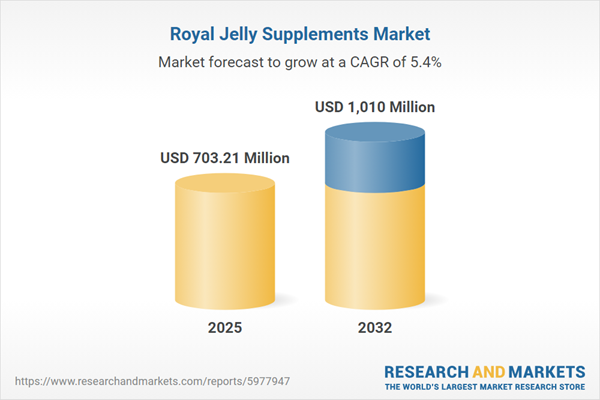Speak directly to the analyst to clarify any post sales queries you may have.
Royal jelly supplements are experiencing renewed industry traction, driven by evolving consumer focus on natural wellness, regulatory clarity, and advances in product science. Stakeholders seeking concise, actionable insight into this dynamic market will gain value from a strategic review based on segmented realities and upcoming policy shifts.
Market Snapshot: Royal Jelly Supplements Market Overview
The Royal Jelly Supplements Market grew from USD 666.52 million in 2024 to USD 703.21 million in 2025, and is projected to achieve a CAGR of 5.43%, reaching USD 1.01 billion by 2032. This expansion reflects rising global demand for natural nutraceuticals, underpinned by consumer preference for immune support, skin health, and increased vitality. Strategic investments in bioactive preservation and extraction are set to define the sector’s competitive evolution.
Scope & Segmentation
This report offers comprehensive analysis across core segments, enabling senior leaders to assess opportunity windows with precision:
- Product Form: Capsules, gels, liquids, powders, and softgels catering to varying absorption needs and user routines.
- Nature: Conventional and organic formulations supporting different sourcing values and certification demands.
- Price Range: Economy, mid range, and premium offerings, addressing diverse budgets and performance expectations.
- Distribution Channel: Direct selling, e-commerce, health food stores, and pharmacy networks extend reach and brand credibility.
- Application: Anti-aging, energy boosting, immunity support, and skin care solutions address targeted consumer needs.
- End User: Adults, pregnant women, and seniors form the main demographic drivers and dictate product positioning strategies.
- Region: Coverage includes Americas (United States, Canada, Mexico, Brazil, Argentina, Chile, Colombia, Peru), Europe (United Kingdom, Germany, France, Russia, Italy, Spain, Netherlands, Sweden, Poland, Switzerland), Middle East (United Arab Emirates, Saudi Arabia, Qatar, Turkey, Israel), Africa (South Africa, Nigeria, Egypt, Kenya), and Asia-Pacific (China, India, Japan, Australia, South Korea, Indonesia, Thailand, Malaysia, Singapore, Taiwan).
- Key Players: Market landscape features Zhejiang Conba Biological Technology Co., Ltd.; Comvita Limited; Forever Living Products International, Ltd.; Yamamoto Bee Products Co., Ltd.; Y.S. Eco Bee Farms, Inc.; NOW Foods, LLC; Swanson Health Products, Inc.; Nature's Answer, LLC; Beevital Bee Products S.A.; and R.S. Ricker, Inc.
Key Takeaways
- Product innovation is accelerating with new delivery formats, offering tailored solutions for varying consumer priorities and enhancing user compliance.
- Sustainable sourcing and vertical integration are gaining momentum, improving supply chain transparency and reinforcing brand trust within ethical consumer segments.
- Digital commerce models are broadening market access, enabling niche players to bypass traditional retail limitations and target specialized audiences.
- Regulatory frameworks continue to evolve, compelling suppliers to invest in compliance and substantiation, which ultimately reassures both end users and distribution partners.
- Strategic partnerships among producers, raw material suppliers, and logistics providers are mitigating sourcing risks and ensuring quality despite global trade fluctuations.
Tariff Impact: United States Import Duties
New U.S. tariff measures in 2025 have increased production costs for manufacturers by introducing duties on select apicultural inputs. As a result, companies are reassessing sourcing strategies, moving toward suppliers in favorable trade regions or scaling up domestic extraction to limit exposure. This shift has also encouraged deeper collaboration between supplement producers and raw material cultivators, supporting better pricing stability and quality traceability. Logistics optimization, through shipment consolidation and updated warehousing approaches, is becoming critical for offsetting increased duties.
Methodology & Data Sources
This report utilizes primary data from interviews with industry executives and technical experts, supplemented by a systematic review of market reports, peer-reviewed publications, and public databases. Quantitative research draws on reliable supply chain analytics and consumer sentiment panels. Findings are validated via data triangulation and peer review to ensure precision and integrity throughout the analysis.
Why This Report Matters
- Supports decision-makers in identifying high-growth opportunities and mitigating regulatory or tariff-driven risks across the royal jelly supplements sector.
- Clarifies complex segmentation, enabling targeted investment in product innovation, channel strategy, and technology acquisition.
- Offers actionable intelligence on the evolving landscape of sustainable sourcing, supply chain integration, and emerging digital commerce trends.
Conclusion
The royal jelly supplements market is shaped by health-driven innovation, regulatory evolution, and shifting sourcing landscapes. Stakeholders who align strategies with these trends will be positioned to unlock resilient growth and sustainable market presence across global territories.
Additional Product Information:
- Purchase of this report includes 1 year online access with quarterly updates.
- This report can be updated on request. Please contact our Customer Experience team using the Ask a Question widget on our website.
Table of Contents
3. Executive Summary
4. Market Overview
7. Cumulative Impact of Artificial Intelligence 2025
Companies Mentioned
The companies profiled in this Royal Jelly Supplements market report include:- Zhejiang Conba Biological Technology Co., Ltd.
- Comvita Limited
- Forever Living Products International, Ltd.
- Yamamoto Bee Products Co., Ltd.
- Y.S. Eco Bee Farms, Inc.
- NOW Foods, LLC
- Swanson Health Products, Inc.
- Nature's Answer, LLC
- Beevital Bee Products S.A.
- R.S. Ricker, Inc.
Table Information
| Report Attribute | Details |
|---|---|
| No. of Pages | 185 |
| Published | October 2025 |
| Forecast Period | 2025 - 2032 |
| Estimated Market Value ( USD | $ 703.21 Million |
| Forecasted Market Value ( USD | $ 1010 Million |
| Compound Annual Growth Rate | 5.4% |
| Regions Covered | Global |
| No. of Companies Mentioned | 11 |









